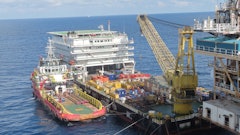
Published Oct. 2.
Dockworker Strike Not Close to Being Over. Here’s Why.
Close to 45,000 dockworkers at 36 ports along the East Coast are still on strike as a result of the International Longshoremen’s Association (ILA) and United States Maritime Alliance (USMX) failing to reach an agreement prior to their Master Contract deadline.
And unfortunately, it looks as though a resolution won’t be reached any time soon.
That’s because the ILA has rejected USMX’s nearly 50% wage increase because “it fails to address the demands of our members adequately. They might claim a significant increase, but they conveniently omit that many of our members are operating multi-million-dollar container handling equipment for a mere $20 an hour. In some states, the minimum wage is already $15. Furthermore, our members endure a grueling six-year wage progression before they can even reach the top wage tier, regardless of how many hours they work or the effort they put in,” ILA states in a press release.
“USMX also overlooks the fact that two-thirds of our members are constantly on call, with no guaranteed employment if no ships are being worked. Our members qualify for benefits only based on the hours they worked the previous year, making them vulnerable if there’s a downturn in work. Despite this, there is no incentive within the progression system for hard-working members to advance faster,” ILA adds.
ILA also remains against any form of automation—full or semi—that replaces jobs or historical work functions.
Another critical issue is Container Royalty, which are funds intended to be a wage supplement paid out to ILA members, not to be shared with employers. The ILA also seeks more than a $5 yearly wage increase.
USMX’s website has been down, so as of press time, was not able to gather information from their side.
While the strike has been planned for weeks, the longer the strike goes on, the worse the impacts will be. Atlantic port closures will have the biggest impact on the West African and Caribbean countries who depend on the United States and Canada, not on U.S. consumers.
“The overwhelming majority of the U.S. economy is domestic or reliant on trade with Canadian and Mexican suppliers. So, while this strike is disruptive to some U.S. manufacturers and retailers, it is not an emergency in the short term,” says Ben Ruddell, director of the FEWSION Project and professor in the School of Informatics, Computing, and Cyber Systems at Northern Arizona University. "Because all Atlantic ports are on strike, there are no easy alternatives for rerouting freight. West Coast ports are weeks away and lack the capacity to absorb this traffic. The labor union is communicating to the world that it controls a whole continent's access to Atlantic trade."
"The U.S. economy is not resilient to a long-term closure of all Atlantic ports. The labor union controls an entire critical infrastructure upon which the nation depends. This is why the U.S. Congress enacted the Taft-Hartley Act to give the President the authority to stop a strike when necessary. The Air Traffic Control strike in 1981 was a similar case, and the president invoked Taft-Hartley in that instance. This may happen again if the strike continues too long," adds Ruddell.
According to Vizion’s Tradeview platform, the number of new shipments entering for import and export at these ports as decreased significantly. The weekly average in July and August was 97K TEUs and in the week of Sept. 22, reduced to 14,895 TEUs.
Based on the last 12 months of shipment bookings in Vizion's Tradeview platform, the affected U.S. ports represent 55% of all U.S. imports, 71% of all U.S. exports, and 27% of global import activity, and 12.5% of global export activity.
The types of imported cargo identified include furniture, bedding and mattresses (54% of the volume for this cargo type are brought in through these ports). Exported goods like plastics (80% of all U.S. plastics exported), wood pulp products (72%), and meat products (77%).
“As we shared yesterday, new bookings for import and export using the impacted ports have decreased dramatically over the last 7 days, but have not in fact stopped entirely. Just yesterday, the Tradeview platform identified 3,423 new shipments confirmed for export and 13,268 shipments confirmed for import,” says Vizion CEO Kyle Henderson.
Day 1 of the strike statistics, according to Vizion’s Tradeview platform:
- 2.45 million metric tons in total cargo weight for shipments scheduled to arrive into USNYC in the next 90 days, currently higher than even LAX.
- 38 billion estimated cargo value for all in-transit shipments scheduled to arrive into the ILA ports in the next 90 days.
- 348 vessels on the water listing U.S. East and Gulf Coast ports as their destination. These vessels have over 441,000 individual shipments identified in Tradeview with 746,000 in estimated TEUs.
- 42,870 TEUs that were gated out (via truck) from these ports on Sept. 27.
- 76,400 TEUs that were gated out (via truck) from these ports on Sept. 30.
- In the past 24 hours, despite the threat of the strike, there have been 48 containerships that have departed from origins overseas with cargo aboard destined for the impacted ports.
“The U.S. port strikes are putting firms on edge. No one wants more U.S. supply chain chaos, least not an administration preparing for an election just weeks away. Estimates show that the strike could end up costing the U.S. economy $5 billion a day, so if this process becomes protracted, heads in DC will likely start to turn," says Alexander Style, GM, Americas at Vinturas. "Savvy retailers will have been preparing for any delays by stockpiling weeks in advance to ensure they are well buffered should any supply chain delays occur, but given lead times on globalized supply chains, anyone looking to move now will likely be too late. As we saw recently with the rail strikes in Canada, even government intervention to prevent economic shut down doesn’t guarantee anything outside the short term, let alone business returning to status quo."
“The strikes will have a big impact on the United Kingdom, in particular," says Jay Dhokia, founder of Pro3PL. "The United States is the UK’s largest trading partner for both exports and imports. Disruption to one of the largest shipping ports and the ripple effect this will have on other trade routes could create challenges for shipping between the two nations. The UK Department for Trade and Business reports that in the four quarters to the end of Q1 2024, trade with the U.S. accounted for 17.7% of the UK’s total trade. Exports of goods from the UK to the U.S. accounted for £61.8 billion in trade over this period, a trade which supports thousands of businesses across the UK and could be a leading revenue source for British businesses. Any disruption to major supply routes puts this at risk, as supply chain managers may need to source alternative shipping routes or risk being caught in a time-sapping backlog."
Published Oct. 1.
Statement from the White House:
"Collective bargaining is the best way for workers to get the pay and benefits they deserve. I have urged USMX, which represents a group of foreign-owned carriers, to come to the table and present a fair offer to the workers of the International Longshoremen’s Association that ensures they are paid appropriately in line with their invaluable contributions. Ocean carriers have made record profits since the pandemic and in some cases profits grew in excess of 800 percent compared to their profits prior to the pandemic. Executive compensation has grown in line with those profits and profits have been returned to shareholders at record rates. It’s only fair that workers, who put themselves at risk during the pandemic to keep ports open, see a meaningful increase in their wages as well.
As our nation climbs out of the aftermath of Hurricane Helene, dockworkers will play an essential role in getting communities the resources they need. Now is not the time for ocean carriers to refuse to negotiate a fair wage for these essential workers while raking in record profits. My Administration will be monitoring for any price gouging activity that benefits foreign ocean carriers, including those on the USMX board.
It is time for USMX to negotiate a fair contract with the longshoremen that reflects the substantial contribution they’ve been making to our economic comeback."
Published Oct. 1.
No industry is immune to the impacts of this strike, according to project44 data, but there are some industries that rely more heavily on the East and Gulf Coasts than others.
Energy and petrochemicals. Gulf Coast ports, especially Houston and New Orleans, handle 60-70% of the U.S. exports of crude oil, refined petroleum products, and natural gas. A significant portion of the petrochemical supply chain, including plastics and chemical feedstocks, also moves through these ports.
Agriculture. About 60% of U.S. grain and soybean exports flow through Gulf Coast ports, with New Orleans being a major hub for agriculture exports from the Midwest.
Heavy manufacturing and machinery. Gulf Coast ports handle around 25-30% of U.S. exports of industrial machinery and heavy equipment, much of it bound for Latin America and Europe.
Retail and consumer goods. East Coast ports manage 35-40% of U.S. consumer goods imports such as electronics, clothing, and furniture. Ports like New York/New Jersey and Savannah are critical for trade with Europe and Asia. Many of these imports are destined for the East Coast and Midwest retail markets.
Automotive. Approximately 30-35% of U.S. automotive imports and exports pass through East Coast ports, especially vehicles and parts from Europe. The Port of Baltimore is a key hub for RoRo (Roll-on/Roll-off) vessels. When the port temporarily halted operations, the industry remained stable by rerouting shipments to nearby ports. However, if a strike occurs in October, disruptions to manufacturing will likely be unavoidable.
Pharmaceuticals and chemicals. Approximately 30-35% of U.S. pharmaceutical imports flow through East Coast ports. This includes active pharmaceutical ingredients (APIs) and finished drugs from Europe, India, and other regions.
Food and beverages. East Coast ports manage 30-40% of U.S. food and beverage imports, including perishables like produce, seafood, and processed foods from Europe and Africa.
Construction materials. Combined, the East and Gulf Coast ports handle about 25-30% of U.S. imports of steel, cement, and other construction materials, primarily sourced from Europe and Latin America.
Matthew Shay, president and CEO of the National Retail Federation (NRF) is urging the administration to use "any and all authority" to end the port strike.
Last month, NRF issued a statement urging the parties to immediately resume negotiations. The group also spearheaded a letter signed by nearly 200 organizations to President Biden urging the administration to intervene and avoid a disruption. In June, NRF led a coalition of 158 state and federal trade associations in a letter to President Biden urging the administration to work with the negotiating parties and to reach a new agreement. Earlier this year, NRF also sent a letter to ILA and USMX calling for the resumption of port labor negotiations.
Eric Hoplin, president of National Association of Wholesaler-Distributors (NAW) is also calling on President Biden to take action.
“The East and Gulf Coast port strike is putting our economy and national security at risk. This strike isn’t just about disrupting a few shipments; it’s about stopping the supply chain and bringing the flow of critical goods to a standstill," Hoplin says. "The damage could reach $5 billion a day, with small and mid-sized businesses at risk due to missed deliveries and empty shelves. The Biden administration must use its authority now to stop the strike before the impact becomes irreversible. This is not just about pay or a shipping delays—it’s about our global competitiveness. The ILA’s demands to ban automation in ports will cripple our ability to compete internationally, while ports in Europe and Asia embrace automation and technology to stay ahead. The administration must act decisively—end this strike, reopen the ports, and ensure the U.S. remains a leader in global trade.”
Published Oct. 1.
Close to 45,000 dockworkers at 36 ports along the East Coast went on strike this morning as a result of the International Longshoremen’s Association (ILA) and United States Maritime Alliance (USMX) failing to reach an agreement prior to the Oct. 1 expiration date.
ILA wants significant wage increases, fair treatment, recapture of Container Royalty funds, and job security. The ILA is also asking for protections against the automation of cargo handling, particularly concerning the use of automated cranes, crucial to safeguarding jobs.
ILA reports that USMX continues to block the path toward a settlement on a new Master Contract by refusing ILA’s demands to protect workers, causing a strike at all ports from Maine to Texas.
“The ocean carriers represented by USMX want to enjoy rich billion-dollar profits that they are making in 2024, while they offer ILA Longshore Workers an unacceptable wage package that we reject,” ILA announced in a statement. “ILA longshore workers deserve to be compensated for the important work they do keeping American commerce moving and growing. It’s disgraceful that most of these foreign-owned shipping companies are engaged in a ‘make and take’ operation; they want to make their billion-dollar profits at United States ports and off the backs of American ILA longshore workers, and take those earnings out of this country and into the pockets of foreign conglomerates. Meanwhile, ILA dedicated longshore workers continue to be crippled by inflation due to USMX’s unfair wage packages. “
For its part, "in the last 24 hours, the USMX and ILA have traded counter offers related to wages,” according to a statement released by USMX. “The USMX increased our offer and has also requested an extension of the current Master Contract, now that both sides have moved off their previous positions. We are hopeful that this could allow us to fully resume collective bargaining around the other outstanding issues – in an effort to reach an agreement. Our offer would increase wages by nearly 50%, triple employer contributions to employee retirement plans, strengthen our healthcare options, and retain the current language around automation and semi-automation.”
However, ILA rejected the offer, resulting in a strike that could possibly cripple global supply chains at time when they’re reaching peak season.
For instance, just one week of a strike at ports results in approximately one month of congestion, backlogs, and delays.
“The market will see equipment imbalances (shortage or surpluses) in certain locations due to the disruption of port and rail activity. This will lead to price increases and using alternative modes of transportation to get cargo to surplus locations,” says Mollie LeBlanc, VP of operations overseeing ocean and air at Uber Freight.
The impact of a strike of this scale to ports will be immediate and widespread, according to FourKites.
"When labor ceases, freight currently at the port will be stuck and vessels scheduled to enter or exit the port will be impacted, causing ripple effects to vessel schedules globally. Vessels will likely have to anchor near ports as they wait, and import and export dwell will skyrocket. There are currently over 100 container vessels scheduled to reach these ports within the next week," according to FourKites data.
In the short term, slowing import demand could leave more truckload supply (capacity) available to support relief efforts while the ports are closed, says David Spencer, VP of market intelligence at Arrive Logistics.
"Additional challenges with sourcing much-needed building materials could build the longer a strike lasts due to the importance of the ports in supplying those materials, reducing product availability and causing rapid cost inflation. In addition to building materials, the port strikes could create meaningful disruptions in supply chains related to fresh foods, auto parts, plastics, furniture, and more, with just-in-time manufacturing being an area of concern as the length of the strike adds up," says Spencer. "In the short term, demand pullbacks should ease rate pressures, but a longer-lasting strike will build up backlogs that have the potential to lead to high rate volatility. Ultimately, this strike could become one of the most disruptive freight market events since the COVID-19 pandemic. While capacity is sufficient to service current demand, growing import backlogs may create tighter conditions once the strike ends. We will continue to monitor the situation as it evolves and recommend shippers maintain open communication with transportation partners."
A prolonged strike could disrupt shipping patterns, including trucking goods into the U.S. from ports in Atlantic Canada, according to DAT Freight & Analytics.
"A short strike would have considerably less impact. Shipping season has peaked as importers mitigated the risk of a strike and moved more goods early and through other ports. July saw an almost 14% year-over-year increase in TEUs entering the United States, and the Port of Long Beach had its strongest month in its 113-year history in August. Volumes have tailed off since then," DAT experts say.
In a perfect world, shippers would have begun simulating the potential impacts of the port strikes weeks or months ago, according to Paul Bellamy, logistics leader at Genpact, "but for those who haven’t, pulling together a robust contingency plan rooted in data and analytics is the immediate next step. Mitigations available now include contingency plans for transporting goods out of ports along the East coast where non-ILA labor is available, as well as other mediums that can handle this capacity. Organizations should consider whether Canadian, Mexican or Great Lakes ports can be utilized in addition to West coast ports for upcoming shipments. Another key consideration is how quickly these changes can be implemented. These simulations will uncover specific route guidance for suppliers to navigate in the next 3-6 months, and potentially much longer, as the situation unfolds. Retail industry shippers have already begun moving inventory for the holiday season and the strike will have big implications for those who are not ahead of the ball, especially with higher-than-normal container shipping costs this year."
What's more, the timing of the strike, just before the holiday season, could exacerbate operational issues and create increased havoc, says Nari Viswanathan, senior director, supply chain strategy at Coupa Software.
"Retailers rely on this period to stock up on goods for holiday shopping, and the strike could lead to shipment delays and shortages, resulting in empty shelves and higher prices for consumers. Retailers might also face increased costs as they seek alternative shipping routes or expedite shipments to meet demand," adds Viswanathan. "Failing to reach an agreement could have severe consequences. Prolonged disruption at these ports would strain the supply chain, leading to economic losses for businesses and potential job losses for workers dependent on these operations. The broader economy could also suffer from reduced trade efficiency and increased costs. The outcome of these negotiations could shape the future of America’s ports and supply chains. A successful resolution might lead to improved labor relations and more stable operations; however, repeated disruptions could prompt businesses to consider their reliance on these ports. Shifting traffic to other regions or investing in alternative logistics solutions are likely outcomes."
The deeper challenge here is determining how ports will integrate advanced technology without displacing workers, adds Richie Daigle, supply chain evangelist at Tive.
"Resolution of the East Coast port strike will hinge on addressing the balance between labor demands and the growing push for automation," says Daigle. "For supply chains already strained by delays, this strike highlights the urgent need for technology that supports workers instead of technology that threatens to replace them—to increase overall shipment awareness and minimize disruption across all modes of transportation. It will take a collaborative effort between labor, management, and policymakers to find a solution that ensures both operational efficiency and job security, while maintaining the flow of goods."
In addition to the immediate logistical challenges, "long-term effects such as labor shortages and increased costs from wage hikes could reshape the industry landscape. Companies may struggle to absorb these rising costs, pushing more pressure onto consumers. Additionally, the environmental impact of stalled shipments, waste from perishable goods, and the potential halt to automation efforts all threaten the sustainability goals many in the industry are striving to achieve," says Douglas Kent, EVP of corporate and strategic alliances at The Association for Supply Chain Management.
However some experts predict a minor disruption in the supply chain, as most businesses and organizations have already put into place many of their peak season prep.
“The labor strikes at East Coast and Gulf Coast ports are generating considerable discussion, but their actual impact on the supply chain for the peak holiday season may be less severe than anticipated. Most holiday merchandise is already in the U.S., so while concerns about delays exist, many shipments for the holiday rush have already made it through,” says Spencer Shute, VP at Proxima. “The immediate impact will likely be felt by manufacturers reliant on these ports for parts in sectors like automotive and industrial production. Consumers may experience shortages of perishable goods, such as bananas, with a fifth of the U.S. banana supply coming through these ports, potentially driving up prices.”
Here's what's already in effect, according to Everstream Analytics:
- Vessels are starting to queue up outside of major U.S. ports, particularly off the coast of Savannah, Charleston, Norfolk and New York.
- As of Oct. 1, more than 38 container vessels are waiting at designated anchorage areas near the ports. That number has grown from 21 on Sept. 30 and just 3 on Sept. 29.
- As of Oct. 1, the combined TEUs on these ships amounts to 267,773 TEUs, up from 150,371 TEUs yesterday, and just 22,044 on Sept. 30.
- Currently, experts aren't expecting many diversions to other ports, so the number of waiting vessels could exceed 100 by the end of this week, if the strike continues.
This is an ongoing situation; stay tuned for more details.
Published Sept. 29.
On Sept. 25, the United States Maritime Alliance (USMX) filed an “unfair labor practice” charge with the National Labor Relations Board (NLRB) against the International Longshoremen’s Association (ILA), requiring the Union to resume bargaining in order to reach a deal.
The ILA represents more than 85,000 dockworkers on the East and Gulf Coasts of the United States.
“USMX filing these charges four days before the expiration of the current Master Contract clearly illustrates what poor negotiating partners they have been,” according to a press announcement released by the ILA. “If it wasn’t for the ILA engaging in serious and productive negotiations, most of the local agreements would not have been settled over the past year.”
"USMX has been clear that we value the work of the ILA and have great respect for its members. We have a shared history of working together and are committed to bargaining,” USMX responded in its own press announcement.
What’s behind the contract negotiations?
ILA wants significant wage increases, fair treatment, recapture of Container Royalty funds, and job security. The ILA is also asking for protections against the automation of cargo handling, particularly concerning the use of automated cranes, crucial to safeguarding jobs. If a new Master Contract Agreement with USMX cannot be reached by Oct. 1, then ILA members will threaten a coast-wide strike.
What’s at stake?
Key ports, such as Wilmington, Delaware, and Baltimore, play crucial roles in importing various commodities and vehicles.
CNN adds that “America could see some shortages of chocolate, alcohol, popular fruit, including bananas and cherries, and even certain cars if the strike lasts a long time. That could mean higher prices for the goods that are available.”
"An East Coast port strike will adversely impact U.S. consumers and companies. In my opinion, I think a strike will occur because both parties seem so far apart in their negotiations. Fifty percent of what is imported/exported goes through the U.S. East Coast ports. This is a critical time for many U.S. farmers, and they are shipping agricultural products all over the world through the East Coast ports. U.S. consumers will start to see lack of inventory and increased prices with such food perishables as bananas, cocoa, coffee, and seafood. If food retailers cannot get this food via the ports, they will have to use air shipments to get these perishable products into their stores which will drive food prices up. The longer the strike lasts, the more chaos we will see within U.S. supply chains. It could impact the U.S. economy by about $5 billion a day,” says Patrick Penfield, Syracuse University Professor of Supply Chain Practice.
What's more, the port strike will affect even more companies than just the big retail and automotive companies.
"Given the operational degradation the middle market has faced in the past few years and the toll of inflation and capital costs, the timing couldn’t be worse. For the companies, unions and government mediators involved in these disruptions, it would be good to remember that pain flows upstream," says James Gellert, executive chairman of RapidRatings. "The East Coast port strike will send shock waves upstream into the suppliers that can ill afford the disruption. In a recent inventory stress test, we determined that for middle market companies an extension of inventory days by 15% would result in a 5% increase in inventory cost. A 25% increase in inventory days would result in a 10% increase in costs. These are alarming burdens to put on companies that are already degraded operationally and buckling under the weight of increased leverage and interest costs. From 2019 to YE 2023, the cash conversion cycle (days inventory outstanding and days sales outstanding minus days payable outstanding) has stretched from 54 days to a whopping 82 days. This 50% increase in how long it takes middle market companies to convert inventory to cash can hardly withstand work stoppage of any material duration."
The East and Gulf Coast ports have seen a 27% year-over-year increase in port calls from vessels from July to Sept. 22, with no signs of slowing down on a week-over-week basis, according to FourKites.
"This trend is consistent with the front-loading of cargo that we've seen all summer as shippers prepare for the potential strike. I suspect a tapering down of the number of vessels this week and next as fears of them being forced to anchor off the coast start to kick in, depending on carriers' contingency plans," says Mike DeAngelis, senior director of international solutions, FourKites.
Oxford Economics warns that a prolonged strike could impact up to 100,000 jobs, and companies will be forced to shift cargo to the West Coast or opt for air freight in order to avoid potential delays.
"The strike could push the container trade into chaos, with ripple effects that potentially will disrupt supply chains well. The congestion and delays at these major ports will severely impact the availability of containers, increase costs, and disrupt schedules. Small traders, in particular, may feel the squeeze as they are more vulnerable to price surges and extended delays in securing and moving their boxes. Businesses are acting now to reroute shipments and secure their container supply, or they risk being left stranded in a congested and costly aftermath,” says Christian Roeloffs, co-founder and CEO of Container xChange.
Immediate supply chain challenges, according to Container xChange.
- Stranded cargo. With 42 container ships scheduled to arrive at the Port of New York and New Jersey alone in the coming days, any work stoppage could leave cargo stranded in transit.
- Rerouting challenges. Redirecting shipments to West Coast ports or alternate East Coast ports could create a logistical bottleneck, especially for goods requiring passage through the Panama Canal.
- Cost escalations. Maersk has already announced a disruption surcharge for all cargo moving to and from U.S. East and Gulf Coast terminals, starting Oct. 21. The surcharge will be $1,500 per twenty-foot equivalent unit (TEU) and $3,000 per forty-foot equivalent unit (FEU), depending on the extent of the supply chain disruption. Hapag-Lloyd plans to implement a "Work Interruption Destination Surcharge" for imports from East Asia on Oct. 19, and a "Work Disruption Surcharge" for cargo from the rest of the world on Oct. 18, both at $1,000 per TEU. CMA CGM will introduce an export surcharge on Oct. 11, set at $800 per TEU and $1,000 per FEU, with a $1,500 per TEU import surcharge. Additionally, starting Nov. 1, they will apply a $1,000 peak season surcharge for imports from the Indian Subcontinent and the Middle East, delayed from the original Oct. 1 date.
Based on Everstream Analytics’ historic congestion and strike data for U.S. ports, it’s anticipated that every 24-hour shutdown of all East and Gulf Coast ports would result in operational backlogs that could take up to 7 days to clear. A weeklong strike from Oct. 1 would thus have repercussions until after the U.S. presidential election. The compounding effects of displaced containers and equipment, disrupted schedules and vessel diversions would likely push the impacts well past the Thanksgiving holidays and potentially into December.
Impacts would likely be less severe if the union decided to go on strike at one port at a time, a tactic the ILWU has used in a similar situation on the West Coast in 2022 and 2023.
“Based on our intelligence, there haven’t been any reports of price hikes at the retail level in anticipation of the strikes. However, a variety of goods are expected to see impacts in the event of strike action, even if it ends up being a partial strike like a work-to-rule order. This includes fruit imports like bananas given the significance of the Port of Wilmington, Delaware, for companies like Dole Fresh Fruit Company and Chiquita Fresh North America and meat exports as 45% of waterborne U.S. pork exports and 30% of U.S. beef exports are shipped via East and Gulf Coast ports. As the affected ports handle about half of the nation’s cargo shipments, disruptions would extend to most categories of goods, including automotive and electronics shipments, other perishables like medicine and pharmaceuticals, and general retail goods,” says Jena Santoro, senior manager of intelligence solutions at Everstream Analytics.
According to the Federal Maritime Commission, "regulated entities are reminded that all statutes and regulations administered by the Federal Maritime Commission remain in effect during any terminal closures related to potential work stoppage at ports in the East Coast and Gulf of Mexico regions. The Commission is directing its Bureau of Enforcement, Investigations, and Compliance to investigate any reports of unlawful conduct of regulated entities. The FMC will prosecute violators to the fullest extent of the law. Common carriers and marine terminal operators (MTOs) must continue to comply with all statutory and regulatory requirements, including rules governing tariffs, service contracts, MTO schedules, the application of and invoicing for demurrage and detention, and all other fees and surcharges assessed. Demurrage, detention, and all other fees and surcharges must be reasonable, clearly defined, and serve a specific measurable purpose."
In the event of a strike, if the wage increase demands by the International Longshoremen’s Association aren’t met, "this could result in a prolonged strike by the East and Gulf coast dockworkers, which could ultimately cause harm to the supply chain systems globally and impact the economy in the long run," says Rich Kulesa, chief risk officer, Dun & Bradstreet. "With the impending increase of imports of Christmas season goods and other Q4 supply chain deliverables, there will be significant potential short- and long-term ripple effects that the strike may have on international trade. Currently, we are already experiencing increased ocean shipping delays due to weather and geopolitical disruptions such as the conflicts in the Red Sea and low water levels in the Panama Canal. The strike could cause more stress to these delays and further hurt the economy, especially during a time when the Fed is expected to decrease rates. The hit that global supply chains may face due to these strikes could reverse this anticipation as the cost of goods and supply shortages may increase given the delays in shipping."
The strikes could also pose a threat to the United Kingdom, in particular.
"The United States is the UK’s largest trading partner for both exports and imports. Disruption to one of the largest shipping ports and the ripple effect this will have on other trade routes could create challenges for shipping between the two nations," says Jay Dhokia, founder of Pro3PL. "The UK Department for Trade and Business reports that in the four quarters to the end of Q1 2024, trade with the U.S. accounted for 17.7% of the UK’s total trade. Exports of goods from the UK to the US accounted for £61.8 billion in trade over this period, a trade which supports thousands of businesses across the UK and could be a leading revenue source for British businesses. Any disruption to major supply routes puts this at risk, as supply chain managers may need to source alternative shipping routes or risk being caught in a time-sapping backlog. “This is especially pertinent for medical supply sources from overseas, including time-critical resources and temperature-controlled deliveries. Medical supplies are one of the U.S.’s major exports to countries across the globe. For example, medical and pharmaceutical products are in the top five goods types imported to the UK from the United States at 7.5% (£4 billion) of the total goods imported in the four quarters to the end of Q1 2024."
“If the strikes do go ahead, there’s no easy fix," adds Dhokia. "For companies concerned about the potential disruption in the East Coast port, it would be wise to explore other transportation routes. Some companies will opt for road or rail freight into different ports to circumvent the problem, but this is more time-consuming and costly and will likely lead to increased costs for consumers. Alternatively, if companies are looking for fast solutions — and can shoulder the increased cost, — there is the option of airfreight. To beat the rush, some companies may wish to pre-book space on airlines for any critical supplies to keep supply chains moving outside the U.S.”
Furthermore, shippers are responding by creating contingency plans that are executed when labor uncertainty continues, according to Matt Muenster, chief economist at Breakthrough.
"[When the Canadian rail strike happened earlier this year], we saw businesses frontloading freight to achieve safety stock or excess inventories that could be used during disruption. Eventually, many businesses removed their freight from potentially disrupted networks in advance of the disruption. Although the Canadian government quickly acted and returned laborers to work, many shippers in the Breakthrough Ecosystem had removed their freight from the network and pursued alternate routes and transportation modes to get their products to market. This process creates a period of elevated freight shipments (ahead of the labor uncertainty) and a period of depressed freight shipments (during the uncertainty), and as certainty returns businesses will move quickly to rebalance their inventories and transportation network," says Muenster.
Stay tuned for updates.




















